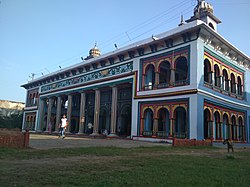Dumraon Raj
Dumraon Raj was a medieval chieftaincy and later a zamindari estate in erstwhile Shahabad district of Bihar (now in Buxar district).[1] The rulers were granted the title of Raja by the Mughal emperor and held a mansab of 1000 zat and 800 sawar making them one of the largest estates in Bihar.[2]
Dumraon Raj | |||||||||
|---|---|---|---|---|---|---|---|---|---|
| 1604–1952 | |||||||||
| Capital | Dumraon | ||||||||
| Religion | |||||||||
| Maharaja | |||||||||
• 1604 | Raja Narayan Mal (first) | ||||||||
• 1952 | Maharaja Bahadur Kamal Shah (last) | ||||||||
| Historical era | Middle Ages | ||||||||
• Established | 1604 | ||||||||
• Disestablished | 1952 | ||||||||
| |||||||||
Origins

The founders of Dumraon Raj were Ujjainiya Rajputs who traced their origin to the Parmar rulers of Malwa who moved to Western Bihar in the 13th century.[4] The various branches of the Ujjainiyas founded various estates in Bihar including Jagdispur, Shakarpura and Dumraon.[5]
One of the major chieftains of Bhojpur, Raja Narayan Mal, received a land grant from the Mughal emperor Jahangir and was conferred the title of Raja in 1604 A.D. His descendant, Raja Horil Singh, moved the capital of Narayan Mals estate to Dumraon which was also called "Horilnagar".[6]
Rulers
The historical papers of the Dumraon Raj are contained within a document called the Tawarikh-i-Ujjainiya which details the history of the chieftaincy as well as some of the earlier rulers including[1]:
- Raja Narayan Mal
- Raja Prabhal Singh
- Raja Sujan Singh
- Raja Horil Singh
- Raja Chhatardhari Singh
- Raja Vikramaditya Singh
- Maharaja Jai Prakash Singh
See also
References
- Brahmadeva Prasad Ambashthya (1959). "Some Historical Papers of Dumraon Raj in the Shahabad district in Bihar". Proceedings of the Indian History Congress. 22: 270–281. JSTOR 44304307.
- Rajiva Nain Prasad (1968). "The Role of Ujjainiya Rajputs in the Political History of Bihar". Proceedings of the Indian History Congress. 30: 167–177. JSTOR 44141471.
- Anand A. Yang (1 February 1999). Bazaar India: Markets, Society, and the Colonial State in Bihar. University of California Press. p. 146. ISBN 978-0-520-91996-9.
- Surendra Gopal (22 December 2017). Mapping Bihar: From Medieval to Modern Times. Taylor & Francis. pp. 293–. ISBN 978-1-351-03416-6.
- Anand A. Yang (1 February 1999). Bazaar India: Markets, Society, and the Colonial State in Bihar. University of California Press. pp. 139–. ISBN 978-0-520-91996-9.
- Sir Roper Lethbridge (2005). The Golden Book of India: A Genealogical and Biographical Dictionary of the Ruling Princes, Chiefs, Nobles, and Other Personages, Titled Or Decorated of the Indian Empire. Aakar Books. pp. 128–. ISBN 978-81-87879-54-1.